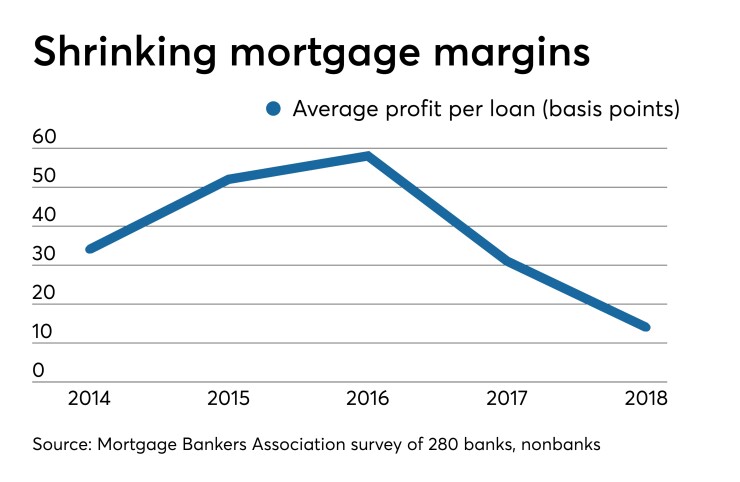It’s no secret the mortgage business has been tough lately, but bankers who have downsized in home lending say it’s no fad — they (and others) predict the slim profits are here to stay and that more banks will follow their lead in scaling back.
Seattle’s HomeStreet Bank, with about $7.1 billion in assets, got its start about a century ago as a private mortgage bank. But it saw its profit margins on home loans cut in half since the 2008 financial crisis. The bank’s national mortgage business managed to break even in 2017 before HomeStreet
Banks have been forced to hold higher capital reserves against mortgage assets after the housing market’s meltdown. Stricter regulations and a stubbornly low inventory of homes for sale — especially ones affordable to first-time buyers — have forced several banks to turn what once was a reliable profit generator into an afterthought service within their branch network.
“We will continue to offer mortgages, but the scale of this business line will be substantially smaller, focused on our retail deposit network and regional markets, and positioned for ongoing profitability,” said HomeStreet CEO Mark Mason.

Boston’s Berkshire Hills Bancorp, with more than $12 billion in assets, decided in April
“What you will see is other banks have a similar conversation about the strategy of a national footprint,” said Gary Levante, senior vice president of corporate responsibility and culture at Berkshire's bank unit.
Some executives within the industry privately cheered JPMorgan Chase CEO Jamie Dimon when he complained in the bank’s
Dimon went further on JPMorgan's earnings call in April, questioning the bank's role in that market.
"We don't mind the volatility. We don't mind staying in the business," Dimon said. "But you've got to look at that and ask a lot of questions about whether banks should even be in it."
Marina Walsh, the vice president of industry analysis at the Mortgage Banker Association's research arm, said that she does not believe there will be a large-scale retreat from financing home loans, but that more firms will consider making moves similar to ones from HomeStreet and Berkshire as they grapple with a bundle of challenges in housing finance.
“It’s just a question of what strategy they want to have,” Walsh said.
Margin pinch
Mortgage banking production profits fell to $367 per loan in the fourth quarter of last year, according to MBA data. That margin has shrunk by more than 50% in the past year and was the lowest recorded by the trade group since it started tracking the data more than 10 years ago.
While falling borrowing costs have shrunk revenues on loans, expenses have increased as more loan production has hinged on costlier purchase mortgages compared to refinancing. The average expense on a home loan written last year was nearly 20% higher than it was four years earlier, according to the MBA data.
About two-thirds of bank mortgage subsidiaries and independent mortgage companies reported making a profit last year, down from more than 93% in 2016, the MBA data show. Half of bank mortgage units reported being profitable.
“They’re just holding on,” Walsh said of those banks still sticking to the business.
The lucrative business of refinancing mortgages had dried up as the Federal Reserve had taken interest rates off near-zero lows held during the past recession. Nonbanks like Quicken and LoanDepot often have a leg up over banks when the market shifts to a mix of mortgages taken out to purchase a home because they are subject to less oversight and, because they are not depository institutions, fewer capital requirements.
To be sure, nonbanks are not the only entities rushing into the market larger lenders are leaving. As interest rates have steadied while the Fed paused its rate-hiking course this year,
Yet the overall downsizing trend is clear. Walsh said there will be even more mergers and acquisitions to come as some lenders decide to divest.
FHA return?
Bose George, an analyst with Keefe, Bruyette & Woods, said everyone is waiting to see whether Dimon follows through with his threats to leave the mortgage business.
But for one section of the market, banks already have.
A staggering 85% of loans underlying mortgage bonds guaranteed by Ginnie Mae in March were written by nonbank lenders, a record high, according to the Urban Institute. Ginnie Mae backs securities made up of mortgages insured by the Federal Housing Administration and the Department of Veterans Affairs.
The FHA, which banks have largely abandoned writing mortgages for, proposed a change recently to take a less aggressive stance toward policing bad lending practices. Banks were hit with multibillion-dollar settlements following the housing market meltdown in 2008 for allegedly violating fair-lending standards, and executives have complained the risk is not worth it.
“Regulations are one of the biggest concerns,” George said after speaking with executives.
Inventory crisis
While banks and their regulators will spar over how much oversight is too much, most will agree there are simply not enough affordable homes for sale.
There was an estimated 5.9-month supply of homes on the market in April, according to the Department of Housing and Urban Development. That number has been on the decline for years since hitting a 10.7-month supply during the height of the foreclosure crisis in 2009. Homebuilders have been slow to put new properties on the market, while the price of existing listings has grown more out of reach.
The median price for homes sold in the first quarter of 2019 topped $307,000, according to Census Bureau and HUD data. That had climbed from a median of about $208,000 during the same period in 2009.
Pinched inventory and higher prices mean fewer mortgages.
“Mortgages historically, it’s a low-margin business with a lot of volatility,” George at KBW said. “There’s a select few who do it. I feel like it fits better with nonbanks. I doubt there’s going to be a big move back.”



